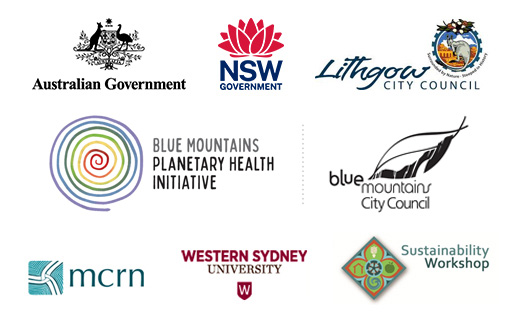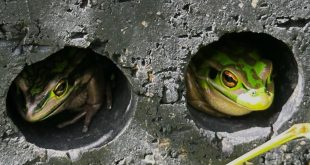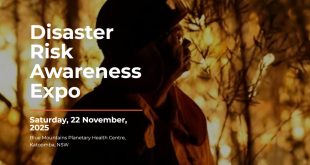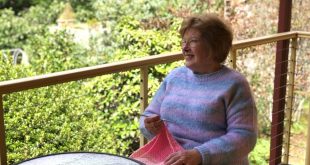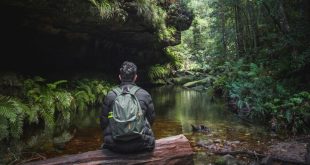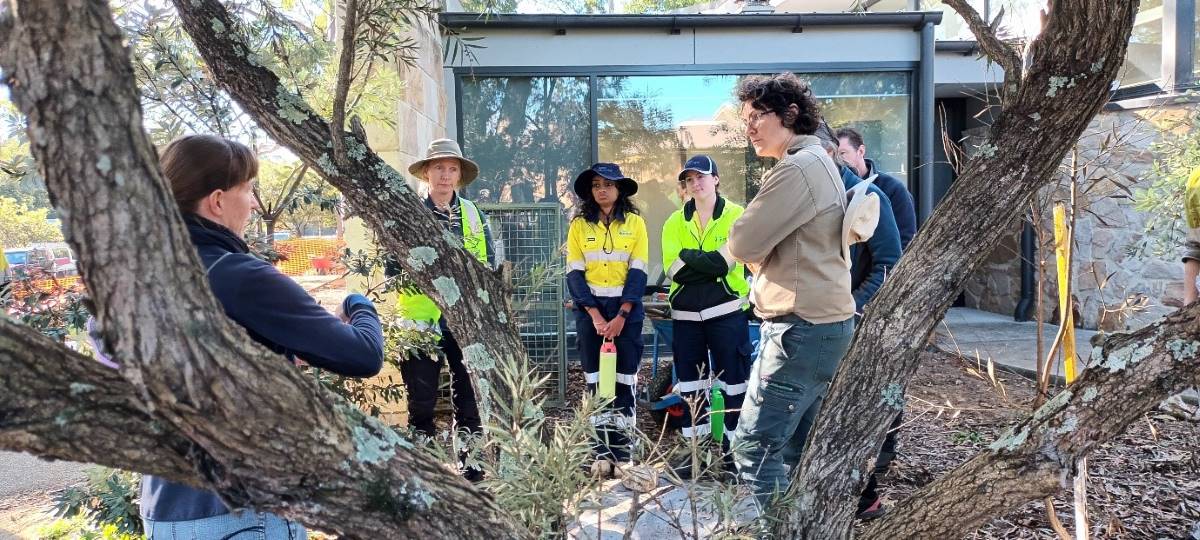
Blue Mountains City Council and Sydney Water employees and volunteers listen attentively as the plan for the Glenbrook Rain Garden is laid out. (Photo: Gabiann Marin)
Story by Gabiann Marin
Water management is crucial, particularly in areas like the Blue Mountains which can be prone to waterway pollution, floods, erosion, bushfires and droughts. Blue Mountains City Council has taken the initiative by creating rain gardens in many catchments to better protect waterways, manage water sustainably and demonstrate how these solutions can be incorporated at different scales, including home gardens.
Most recently Council teams and contractors collaborated with Sydney Water to create three different types of native rain gardens at Glenbrook Visitor Information Centre, showcasing how sustainability and beauty are the natural features of these innovative but simple water management solutions.
Key Points:
- Unmanaged stormwater from built up areas can cause severe damage to our natural areas.
- Creating rain gardens to manage water can help reduce the impact of flooding and water pollution and create more drought resistance.
- Rain gardens can be included in most backyards to help manage water.
It was 9 am on a clear Friday morning as the team assembled outside the Glenbrook Visitor Information Centre. Their mission: to transform the scraggy piece of land on the western side of the Centre into a rocky swale and rain garden, an innovative approach to help manage the flow of stormwater into nearby Knapsack Creek. On the other side of the building, an empty raised garden bed sat, waiting for the team to connect it to a downpipe and bring it to life as a planter-box rain garden.
Amy St Lawrence, Blue Mountains City Council Aquatic Systems Officer, had first started discussing plans for these rain gardens with the Visitor Information Centre team six months earlier, after serendipitous conversations with Visitor Information Officer Benjamin Williams and the Visitor Information Centres Coordinator Boden Evans, who were keen to do something with the site. Buoyed by the VIC team’s enthusiasm, Amy gained support from Sydney Water, who funded the project, and Council teams including Open Space, Natural Area Management and Facility Management. In preparation for the working bee, specialist local contractors, The Bush Doctor and Shannon’s Excavations, spent two days constructing an in-ground rain garden, ready for the rocky swale to connect to. Environmental Engineer, Alexa McAuley, developed concept designs for the swale and planter box and then facilitated the working bee to build them: a great learning opportunity for participants.
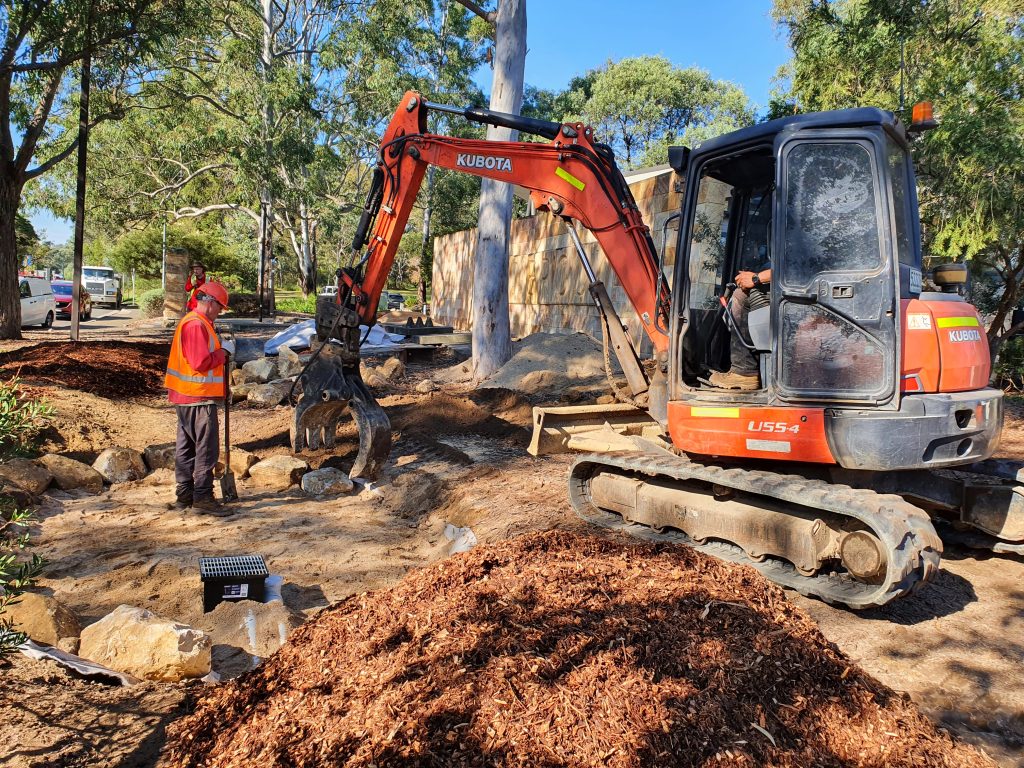
Doing the preparation before the working bee (Image supplied)
When it came time for the working bee, the labourers donning gloves and raising their tools to transform the space included members of council’s Gardening, Healthy Waterways and Natural Area Management and Visitor Information Centre teams, as well as Graduate Environmental Scientists from Sydney Water.
The Visitor Information Centre rain gardens are part of a larger joint Sydney Water-BMCC project focused on treating stormwater at multiple sites in Knapsack Creek catchment.
The project is part of Sydney Water’s pilot scheme under the Hawkesbury-Nepean Nutrient Management Framework, implemented by the Environment Protection Authority (EPA). Jenny Rogers, Sydney Water’s Environmental Regulatory Manager, said the works will allow the water utility “to monitor, calculate and show how effective these rain gardens are at stripping nitrogen and phosphorus from flows, from one end of the system to the other.”
“By working with Council we can help achieve significant reductions in stormwater pollutants reaching the river, complementing our efforts at sewage treatment plants in the Hawkesbury-Nepean region. The rain gardens at the Visitor Centre are a great way to inform the community about the importance of this work”.
While most of these treatment systems will be larger rain gardens and rock-lined channels retrofitted at ‘end-of-pipe’ stormwater outlets, the VIC site provides a perfect opportunity to demonstrate to visitors and locals the types of smaller-scale rain gardens that could be built at home. Having each property in a catchment managing its own runoff is vital in improving waterway health, and solutions like rain gardens come with additional benefits including drought resistance, urban cooling and flood mitigation.
With most of the VIC roof water already directed into a rainwater tank and used to flush the Centre toilets, the rain garden project aimed to complete the ‘water sensitive’ approach at the site, diverting the remaining two downpipes that were still connected directly to the creek via the stormwater line running beneath the highway.
In a land where we have long been prone to extreme weather events including bushfire and flood, managing water has become a key focus of the Council’s sustainability initiatives. Recent large-scale crises in our waterways, like the devastating crayfish kill in Hazelbrook, have highlighted the need to educate everyone on ways to ensure that water flowing into our creeks, lagoons and rivers is as healthy as possible.
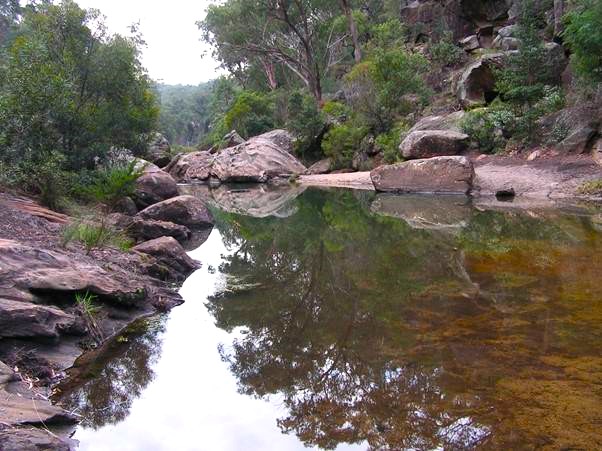
Jellybean Pool, Glenbrook: one of the beautiful natural waterways which can be protected through the use of effective water management. (Photo: Creative Commons)
Stormwater runoff from rainfall hitting urban areas forces too much surface water to move too quickly into aquatic environments. It can have a surprisingly negative impact upon our natural waterways and ecosystems, eroding creeklines and swamps and too efficiently transporting contaminants such as herbicides, pesticides and nutrients into our river and creek systems.
But isn’t water from rooftops clean?
Amy says that people often question why water running off roofs needs to be treated: isn’t it just rain? She says it’s true that water flowing from a roof will usually be cleaner than water that has flowed through gutters, streets and carparks, but it can still carry pollutants deposited on the roof from the natural atmosphere, animal faeces or air pollution such as vehicle emissions.
Alexa explained that deposition from the air means high nitrogen levels are common in roof runoff, which is quickly funnelled down drain pipes and stormwater systems, straight into our creeks, creating problems for animals and plants.
Greater urbanisation and climate change have added to the problems, replacing naturally-occurring bio filters like native grasses, plants, sand and gravel with concrete and asphalt driveways, roads and footpaths. These cannot absorb the rain, causing it to flood down into the waterways unfettered. A big part of the rain gardens’ function is to reduce the volume of stormwater hitting the creek, as well as the pollutant load.
“If we can encourage everyone to capture, filter and reuse stormwater runoff, our creeks would be much healthier and our whole ecosystems would benefit,” Emma Kennedy, Council Environmental Education Officer for Healthy Waterways said. She, along with her colleague Gill Fitzgerald, were just two of the people across Council who helped build one of the simplest solutions for stormwater runoff, a rain garden.

Amy gathers sandy soil around the stormwater drain in the newly created in-ground rain garden, to help slow down and filter the rainwater before it enters the creek and waterways. (Photo: Gabiann Marin)
How do rain gardens work?
Rain gardens are purpose-built water filtering systems that are designed to catch and slow down water runoff from roofs, driveways and lawns: slowing down the flow and allowing the water to be filtered through gravel and sandy soils. Infiltration style rain gardens also help recharge groundwater and retain moisture in the ground. You can learn more about how to build one here.
Rain gardens work best when they incorporate plants which are native to the local region. If designed effectively, they can absorb much more water than the average lawn, and hold it in the soil for a longer period, offering more efficient water use during times of drought and providing better water management to reduce flooding during heavy rainfall.
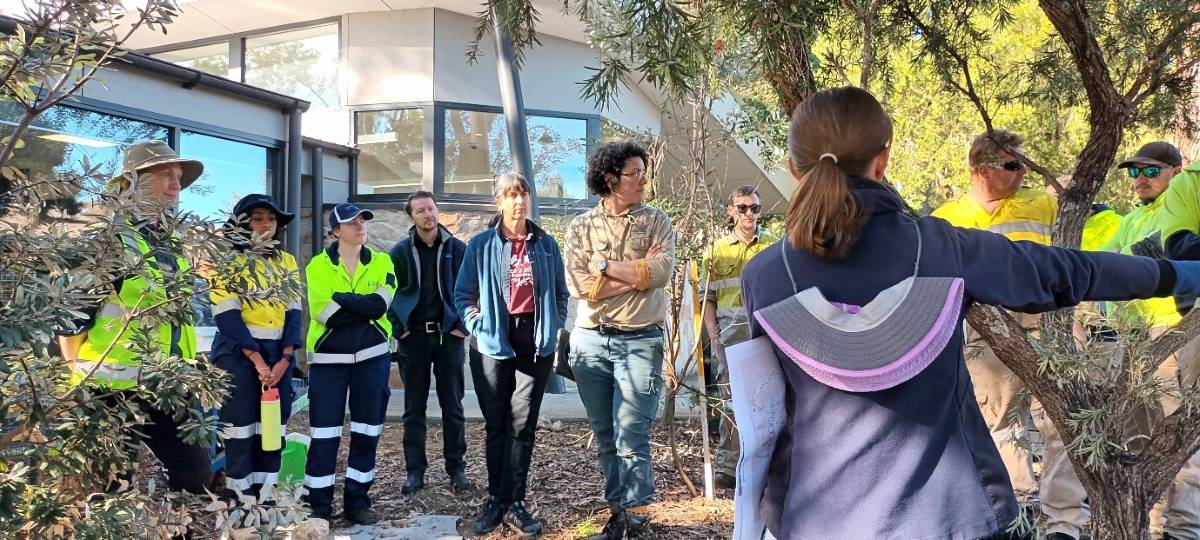
Council workers joined Environmental Engineer Alexa McAuley and workers from Sydney Water to make the Glenbrook Visitor Information Centre rain gardens a reality. (Photo: Gabiann Marin)
Thanks to the combined efforts of the contractors and the working bee teams, the VIC is now a great place to have a look at three different kinds of rain gardens: the rocky swale, the in-ground cell and the planter box.
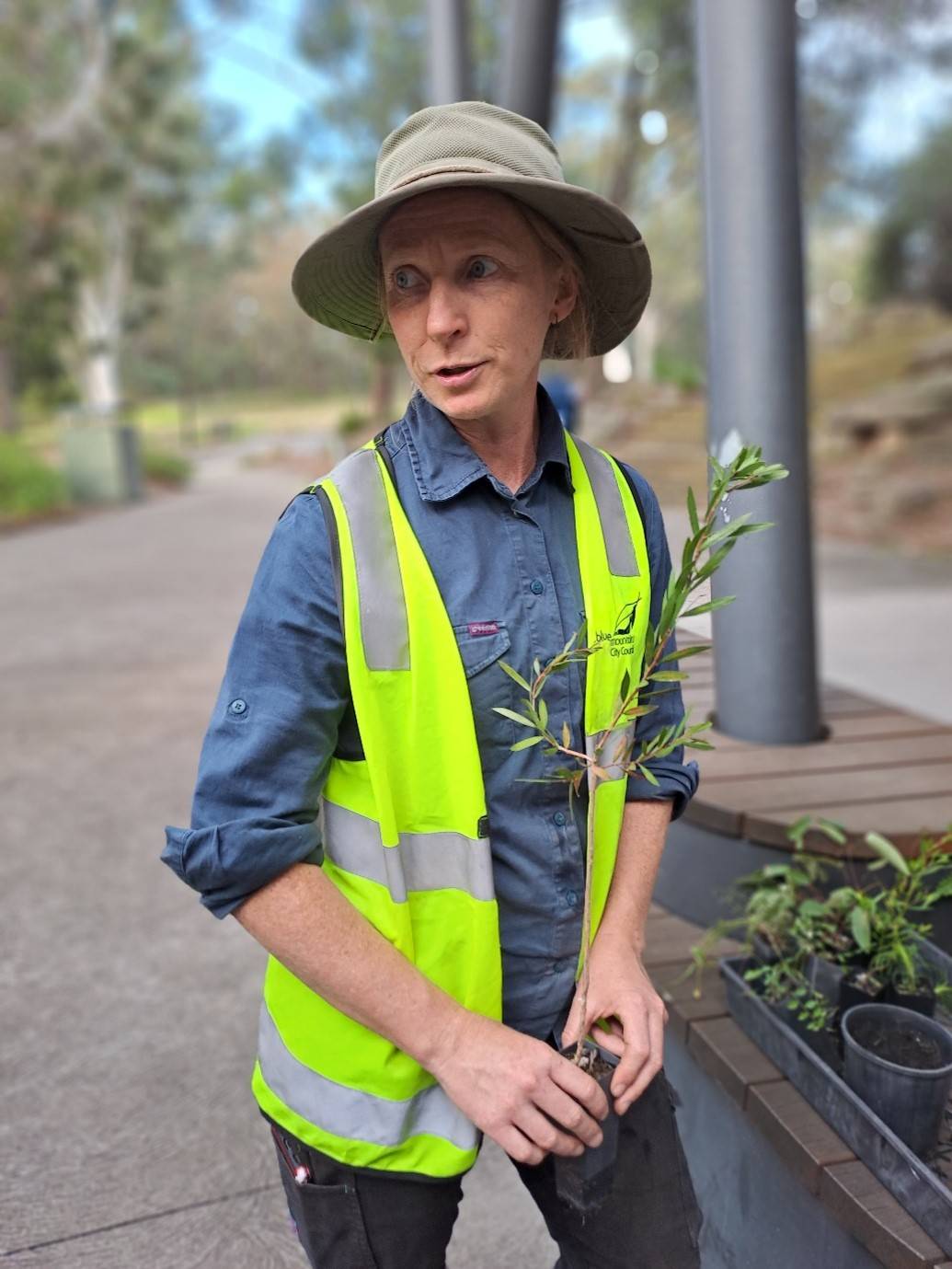
“These gardens aren’t just environmentally effective, but also quite beautiful.” Amy St Lawrence, Blue Mountains Aquatic Systems Officer at the Glenbrook rain garden site. (Photo: Gabiann Marin)
“This is a great opportunity to not just reduce the stormwater impacts on Knapsack Creek, but also to give locals and visitors an opportunity to see real rain gardens in action,” Amy explained.
Amy created a rain garden system on her own property and was keen to show that they can be done quickly and efficiently in a wide range of situations.
The raised garden bed is a clever and versatile variation of an in-ground rain garden, which can be installed even in built up areas which may not have access to an established natural area or garden.

A smaller self-contained rain garden was also built on the concrete entrance to the Centre. (Photo: Gabiann Marin)

Council Horticultural team: team leader Darren Dowling (far right), with Noel Abbott (centre) and Jamie Bell (Photo: Gabrielle Marin)
Shreyaa Sundararaghavan and Lauren McKnight, two graduate environmental scientists working with Sydney Water, were also on hand to partner in this project. Although neither of them had ever created a rain garden before, they quickly took over the creation of the smaller, self-contained rain garden bed, proving that this garden option can be completed in one day with just two people on hand.

Sydney Water, represented by Graduate Environmental Scientists Lauren and Shreyaa, partnered with BMCC to help make the rain gardens a reality. (Photo: Gabiann Marin)
In front of the Centre the rocky swale was beginning to take shape, transforming an eroded area into a beautiful natural looking space which resembled a dry native creek bed.

The Horticultural teams helped transform the front of Glenbrook Visitor Information Centre. (Photo: Gabiann Marin)
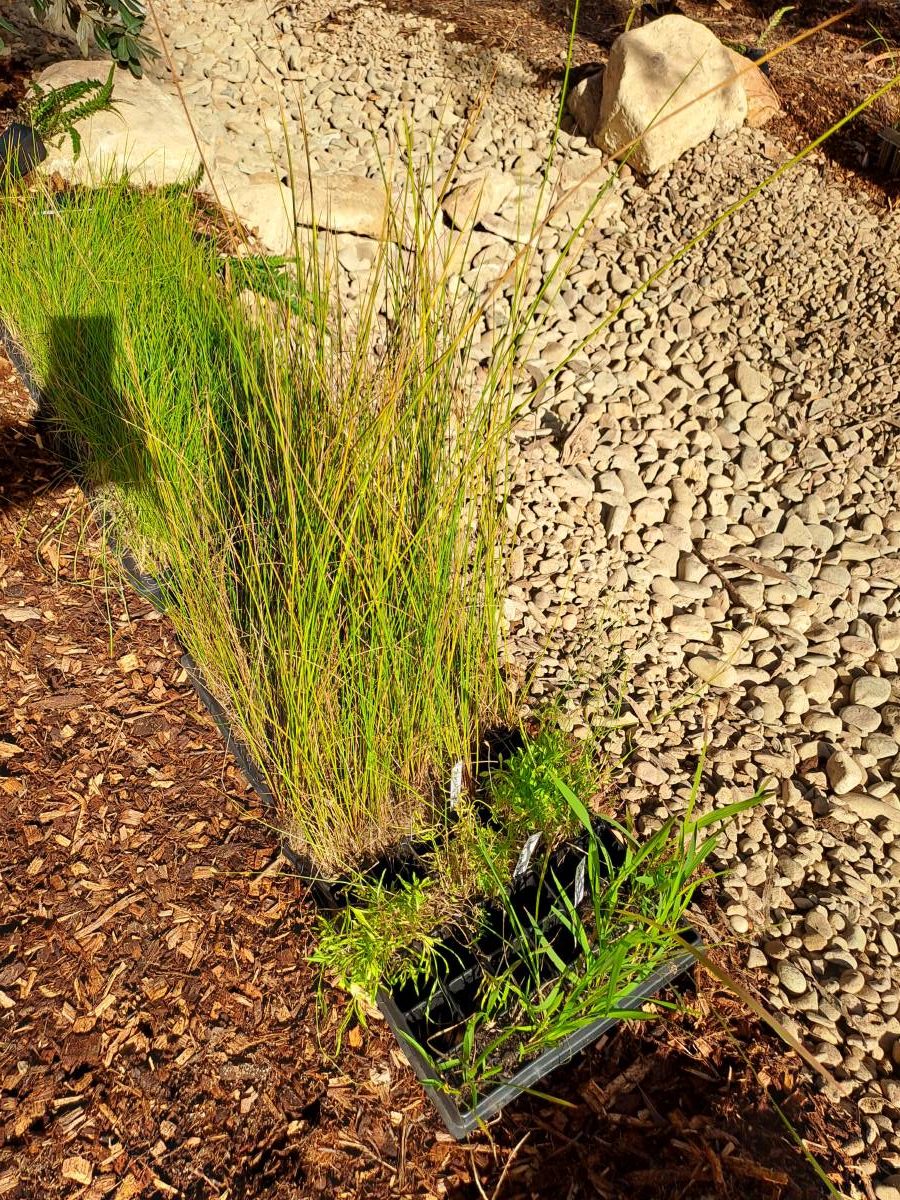
With hundreds of native plants, and several tonnes of gravel, sand, rocks and mulch, the Glenbrook rain gardens start to take shape. (Photo: Gabiann Marin)
By 2pm the majority of the space had been completed and it was time to add the native grasses and plants, which had been specially selected to complement both the design and purpose of the gardens.
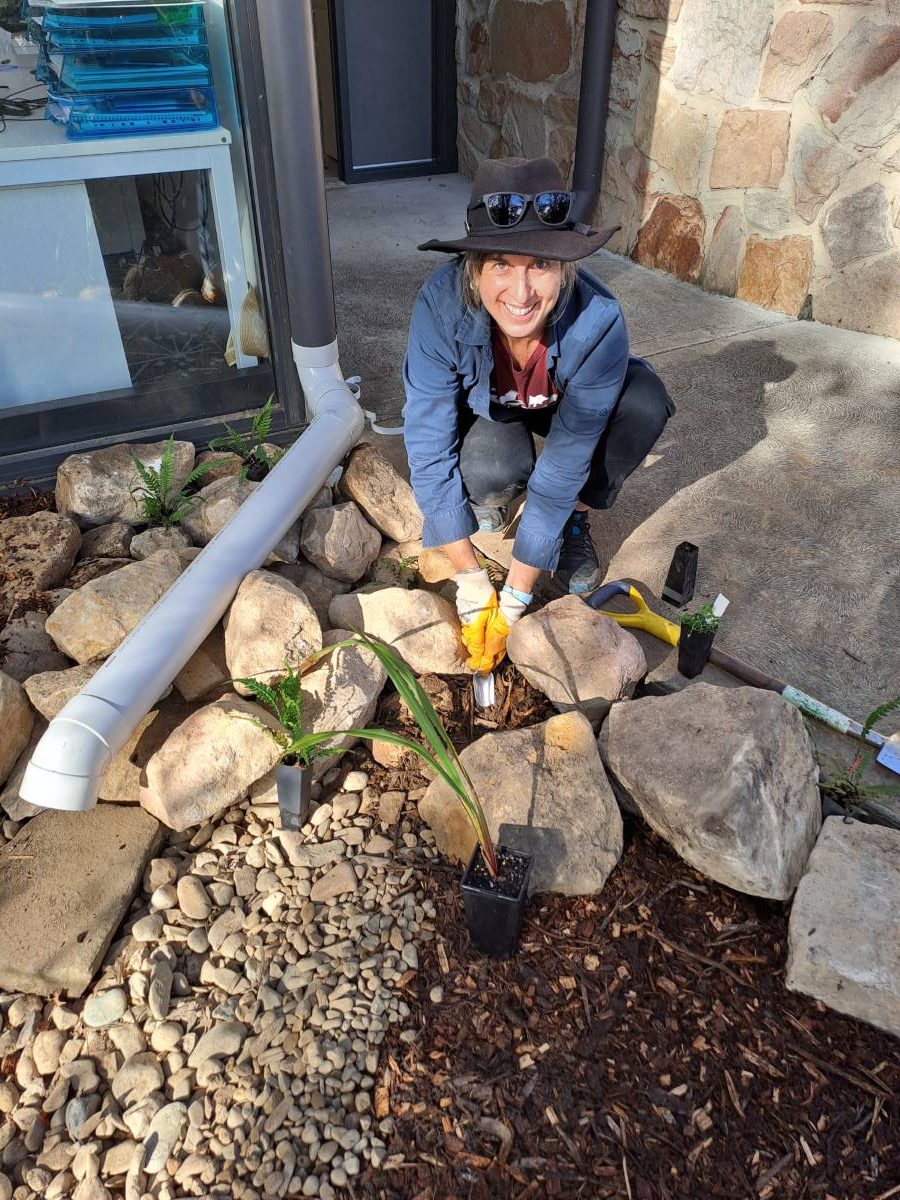
Education and Engagement Officer, Healthy Waterways, Gill Fitzgerald plants seedlings to improve the function of the raingardens. (Photo: Gabiann Marin)
Over on the other side of the building Shreyaa and Lauren had also almost completed the smaller rain garden bed and began consulting with Amy about the best plants to show it off. Amy was careful to select a pleasing mix of colours, choosing a range of local native sedges, ground covers, ferns and small flowering shrubs as well as non-local native kangaroo paws, as suggested by the VIC staff, for an extra show of colour in this urban setting.
In the rocky swale rain garden the plants were mostly native grasses, sedges, ferns and flowering ground covers, with species placed according to levels of light and shade and expected moisture in different areas. The in-ground rain garden was planted with tree ferns as well as a similar selection of local sedges, ferns, grasses and flowering ground covers. Species that generally do best in rain gardens are those that can tolerate dry spells with short periods of inundation.
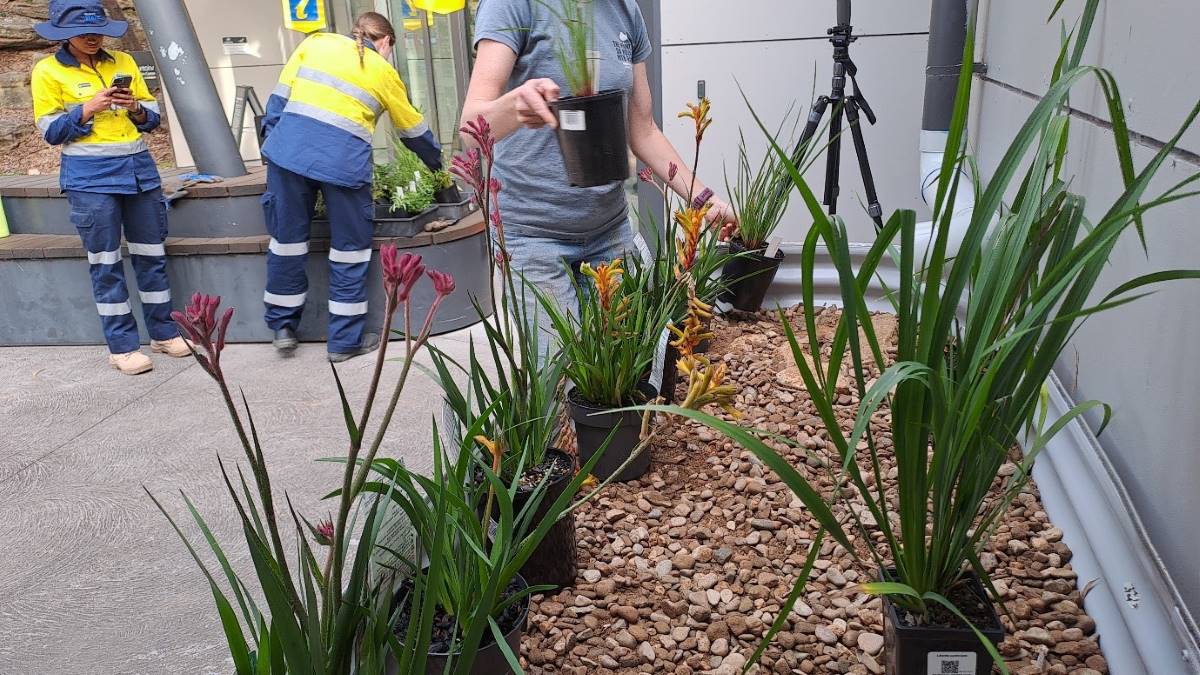
The smaller rain garden has more of a flower bed look to complement the Centre’s entrance way and provide a splash of colour. (Photo: Gabiann Marin)
In one day the group of under 20 people installed the planter box rain garden, fitting pipes and adding layers of gravel and sand; built the rocky swale; redirected the downpipes to feed water into these systems; and plumbed in overflow points to ensure the gardens don’t cause flooding issues at the site in torrential rain. They put finishing touches on the previously built in-ground rain garden and planted hundreds of mostly local native plants. Alexa even painted the new sections of pipe to match the existing downpipes on the building!
As the sun lowered in the west, the workers took a well-earned break to view their handiwork. The rain gardens were almost complete, with the plants perfectly positioned to give the Centre a new environmentally and aesthetically pleasing focal point. The garden was temporarily netted off to ensure the plants would have a chance to fully establish themselves, but everyone agreed the site was now ready to take on its role as environmental bio filter and sustainable stormwater solution. Sydney Water and Council plan to include the site in their water quality monitoring programs for the Knapsack Creek project, to measure the levels of pollutants, including nitrogen, flowing into and out of the raingardens.
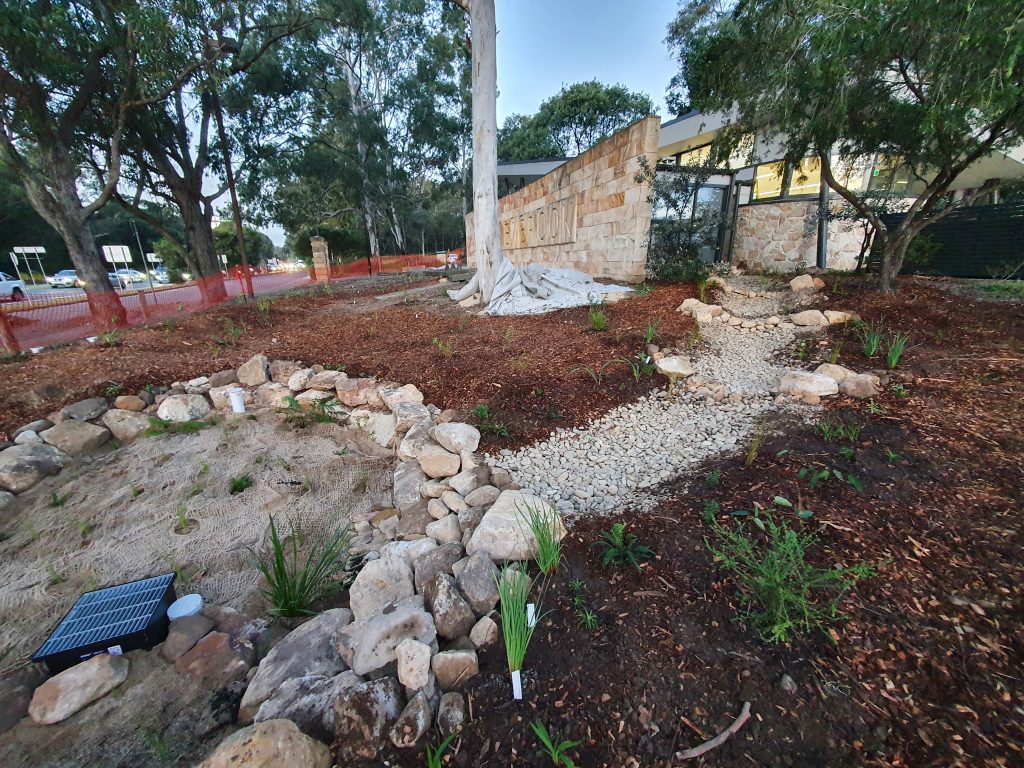
The finished raingarden (Image supplied)
As it turned out the gardens couldn’t have been completed at a better time, with a heavy rainfall spreading across the Lower Mountains in the following days, gushing water down the drainpipe and into both gardens: where it soaked in beautifully and proved that all the effort was worth it.
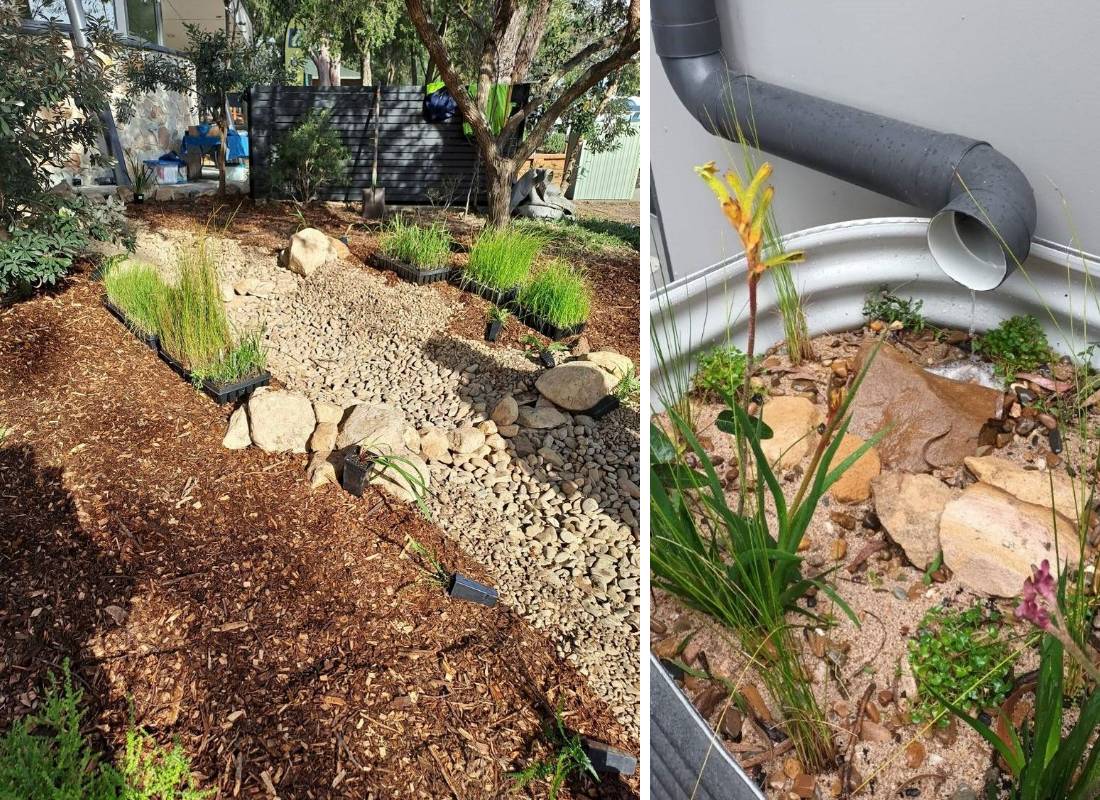
After a week of rain the rain gardens performed brilliantly. (Photo: Gabiann Marin)
Take Action:
- Be Waterway Aware – Keep our waterways healthy and clean by minimising the use of fertilisers and pesticides in your garden. These can be picked up by stormwater, and even small amounts can have huge effects on our waterways.
- Visit the Glenbrook rain gardens – Although visitors are prevented from directly accessing the landscaped rain garden in order to allow the garden to establish itself more fully, you can view the planter box, in-ground and rocky swale rain gardens at the Glenbrook Visitor Information Centre, to help you visualise how these solutions could be incorporated onto your own property.
- Build a rain garden at home – You can find instruction sheets for rain gardens similar to the planter box, swale and in-ground style rain gardens built at the VIC here. Install a rainwater tank to collect water from your roof, and use this water for flushing toilets, laundry and irrigation (it’s best to use the water so there is space in the tank for the next rain event, to help prevent runoff from your property). On some sites, the perfect setting for a rain garden is to capture overflow from a rainwater tank.
Share this article:
This story has been produced as part of a Bioregional Collaboration for Planetary Health and is supported by the Disaster Risk Reduction Fund (DRRF). The DRRF is jointly funded by the Australian and New South Wales governments.
